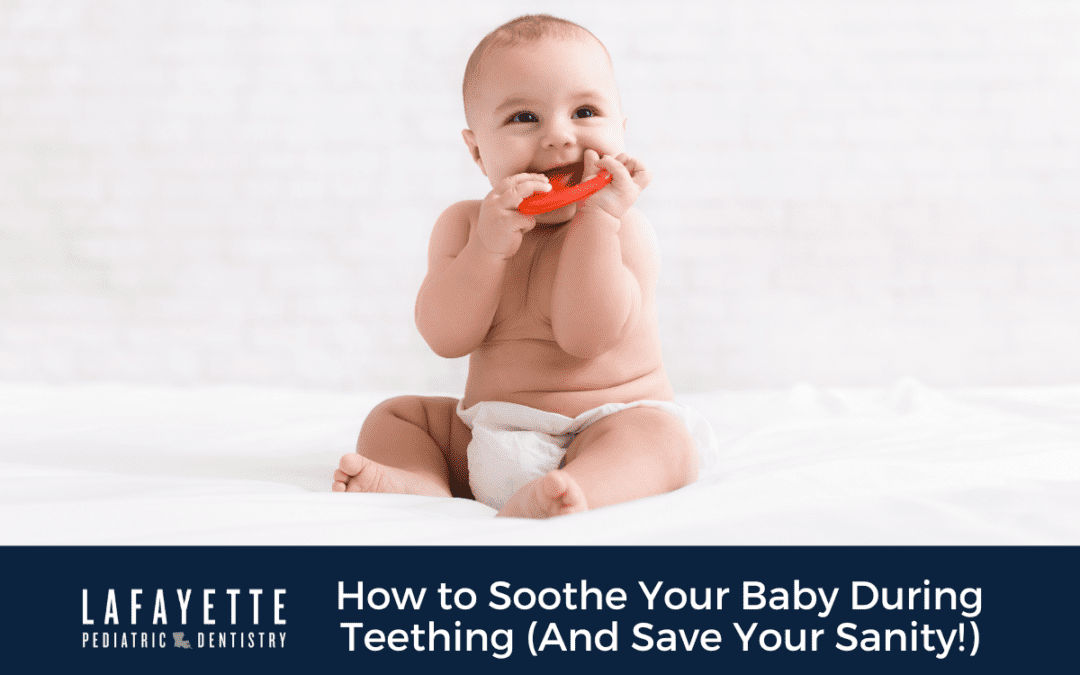Any parent who’s been through teething knows those long nights. Your baby’s crying, nothing seems to help, and you’re running on empty.
The endless fussiness, the constant need to be held. It’s enough to make any parent feel overwhelmed.
And let’s be honest, watching your little one struggle with teething pain is tough. Those peaceful days can suddenly turn into a marathon of soothing a cranky baby who just wants comfort.
Between the sleepless nights and trying to manage daily tasks with a clingy baby, you might feel like you’re barely keeping it together.
As pediatric dental specialists, we see parents almost every day who are exactly where you are right now. Tired, worried, and looking for relief (both for their baby and themselves).
But this phase won’t last forever, and there are ways to make it easier for everyone.
Is My Baby Really Teething or Is It Something Else?
The truth is, it can be hard to tell if your baby is teething, especially if you haven’t seen any teeth yet. But if your baby is around 6 months old, a few common signs may help clue you in:
- Lots of drooling. Teething babies often drool more than usual, so you might find yourself changing clothes and bibs more frequently.
- Chewing on everything. Babies going through teething tend to chew on whatever they can grab—fingers, toys, blankets, or even their own hands.
- More fussiness. Teething can make babies a bit crankier or restless.
- Ear pulling. You might see your baby tugging at their ears, which can be a sign of discomfort.
These signs are not guaranteed, and every baby is different. Some start teething around 4 months, while others may begin as late as 14 months! The average age the first tooth appears is around 7 months.
Some babies also seem to go through months of teething before their first teeth finally break through, while others show few signs and seem less bothered by the process.
If something feels off or you’re not sure if it’s teething or something else, it’s best to check in with your pediatrician or pediatric dentist.
Read more: A Complete Guide to Primary Teeth Eruption
How to Help Your Baby (and Yourself) Through Teething
Mesh Teether with Favorite Frozen Fruit or Veggie Puree
Using a mesh teether filled with a frozen fruit or veggie puree can work wonders for sore gums. Try adding your baby’s favorite fruit or veggie puree—like mashed banana or carrot puree—then freeze it.
The cold helps soothe aching gums, and the taste keeps your baby engaged and calm. This also gives them a healthy, tasty distraction that’s safe to chew on.
Breastmilk or Formula Popsicles
Frozen breastmilk or formula popsicles are an easy way to give your baby cooling relief without introducing anything new. Pour breastmilk or formula into popsicle molds or an ice tray and freeze.
Your baby will enjoy the soothing cold, and the familiar taste adds extra comfort. These popsicles are simple to make, safe, and nutritious.
Teething Toys
A good teething toy can be a lifesaver during this phase. Look for toys made from a single piece of solid rubber or silicone, as they are safe for babies to chew on without the risk of breaking.
Avoid toys that are liquid-filled or have multiple parts, as they can break open and create a choking hazard or develop sharp edges over time.
Steer clear of teething necklaces or any items that go around the neck. They can pose choking or strangulation risks if they break or get caught on something.
You can also check out our review of teething toys available at Target here: https://www.facebook.com/reel/458887966513920.
Frozen Damp Washcloth or Pacifier
A frozen, damp washcloth or pacifier is another simple but effective option. The texture of the washcloth provides soothing pressure on sore gums, while the cold helps numb the pain.
Frozen pacifiers are another alternative; just be sure to monitor your baby while they use them, and keep extras on hand for quick relief.
Teething Gels
If you’re considering a teething gel, choose one that’s made with natural ingredients like chamomile, rosehip, or clove oil.
These are gentler options for babies and avoid some of the harsh chemicals in traditional teething gels.
Avoid products containing Benzocaine (found in brands like Anbesol or Orajel) or Belladonna, as these can be unsafe for babies and may cause adverse reactions.
Medication
If all else fails, Infant Tylenol can help manage pain as a last resort. Dosages can be given every four hours as needed to provide relief when your baby is especially uncomfortable. For babies over 6 months old, Ibuprofen is another option, which can be given every six hours.
Always check with your pediatrician before giving medication to ensure the right dosage and safety for your baby.
What About Celery and Green Onions for Teething?
You’ve probably come across posts on TikTok, Reddit, and parenting forums about using celery and green onions to soothe teething babies. You might be wondering if it’s actually safe or just another internet trend.
Some parents use frozen celery sticks and green onions to help with teething discomfort. Celery contains eugenol, a natural compound with numbing properties, which provides a mild anesthetic effect.
 This can help ease some of the discomfort your little one might be feeling during teething. Green onions, on the other hand, are known for their anti-inflammatory properties, which can help reduce swelling and irritation in sore gums. They also have analgesic qualities, which can relieve pain naturally.
This can help ease some of the discomfort your little one might be feeling during teething. Green onions, on the other hand, are known for their anti-inflammatory properties, which can help reduce swelling and irritation in sore gums. They also have analgesic qualities, which can relieve pain naturally.
However, there are drawbacks. Both can break apart and create choking hazards. That’s why while they contain substances that can ease your child’s teething discomfort, we generally don’t recommend using veggies as a teething remedy.
Celery also contains certain plant compounds that react with sunlight and can irritate sensitive skin. Some babies can develop a rash around their mouth due to a condition called phytophotodermatitis, also known as “margarita burn.”
So, while celery and green onions have properties that might help with teething, they also come with risks.
Always Remember That This is Temporary
It might feel like an endless journey, but always remember that teething doesn’t last forever. Once those teeth finally come through, your baby will start feeling better—and so will you. In the meantime, these strategies can help make the experience a bit easier for everyone involved.
Read more: Understanding Your Child’s Irregular Tooth Growth: Advice from Our Dental Experts
Keep an Eye on Your Baby’s Hydration During Teething
During teething, it’s common for your child to eat and drink less because their gums hurt, so it’s important to keep an eye on their hydration. Dehydration is especially dangerous for babies.
One way to check for dehydration is by looking at the number of wet diapers they have each day; you want to see about 4 to 6, as this indicates they are getting enough fluids.
If you’re concerned about your baby’s hydration or overall comfort, it’s a good idea to reach out to your pediatrician for advice.
Teething can be a tough time for both babies and parents, but it’s temporary. This phase is a natural part of your baby’s development, and while it can bring discomfort, it also means your little one is growing.
If you have any questions about teething or need guidance on how to soothe your baby, feel free to contact our Lafayette pediatric dental office. We are here to provide resources, tips, and support to help you and your baby through this phase.
